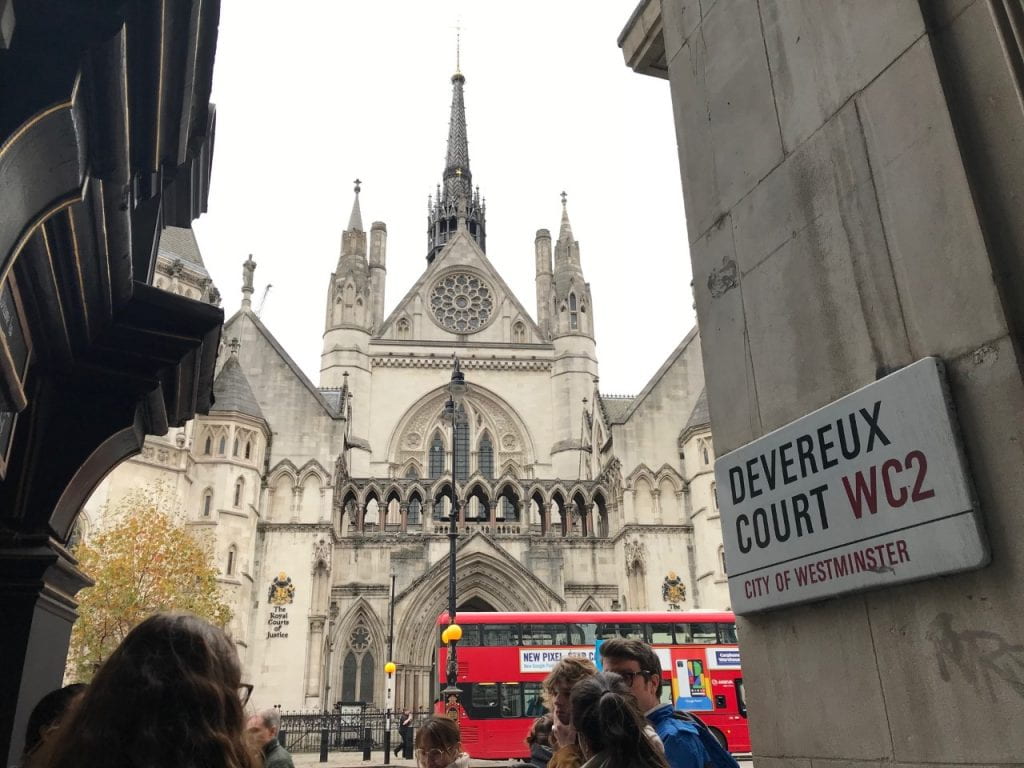
On Friday, 15th November a group of librarians and researchers met with Andrea Milns, who arranged the visit, and Stephanie Curran, the librarian. Despite several groups standing in front of the building, there were no mistakes when trying to identify attendees for our visit.
After going through security checks we were informed that no photos can be taken inside the courts, but we will be able to take photos of the library. While walking through dimly lit corridors and staircases towards the library, we stopped to have a look at the exhibition of legal robes, costumes and manuscripts.
The Library was created as reference and lending library for barristers and clerks. Members of the legal profession were able to visit on librarians’ discretion and consult material not available to them elsewhere. Librarians were paid from subscriptions from library users and the library used to be referred to as 5th Inn. The national library and information service to support the courts and the judiciary was not established until 1968 within the Royal Courts of Justice, or the ‘Supreme Court Library’ as it was called then, and it incorporated several earlier private ventures. A separate library service based in the Bar Library, which had been originally established by the Inns when the Royal Courts of Justice were built in 1884, was closed in 2004 and this service no longer exists. The library collections remaining within the Royal Courts of Justice have been reorganised into a RCJ Library for the judiciary.
Current team of the Judicial Library and Information Service consists of six members of staff. We met Stephanie, Philip, Nick and Christine, the newest member of staff, who just joined the day before our visit.

The Library consists of two rooms: the old Bar Library and Probate Library. In old Bar Library there are the Inns of Court shields, and copy of screen from Lincoln’s Inn entitled Justice: A Hemicycle of Law-Givers by George Frederick Watts on the walls.
Main printed collection ends around 2007, and any later editions are available in electronic format only. The holdings consist of extensive reference collection, texbooks, human rights cases and reports, Halsbury’s laws and statutes. Library books can borrowed, but must be returned urgently when required by a judge. The material refers to UK and Commonwealth, not as much to Europe anymore, as another source called Europa is available online. 300 judges situated in the court also receive budget to spend on texts, law reports and journals, however the tradition of the English legal system is that judges do not rely on their own legal research but on research by counsel.
The library uses Moys Classification Scheme, which is a system for legal materials. It was designed by Betty Moys and first published in 1968. It is used primarily in law libraries in many common law jurisdictions such as Canada, Australia, New Zealand, and the UK. It looked quite complicated, but we were assured it is very easy to use.
We have also visited areas of the RCJ where other library collections are kept. One of those was Times library which houses historical collection and donation of bound and very heavy volumes of The Times from 1939 to 1977. As we walked further, we were able to see collection of printed reports dating back to early 17th century and find out about 1865 reports crisis. As a result The Law Reports series started to be published by The Incorporated Council of Law Reporting. Prior to this, a proliferation of ‘nominate’ law reports were published varied on quality and accuracy.

The visit finished with a hot drink, biscuits and a very lively chat that turned into heated discussion about future of the libraries.